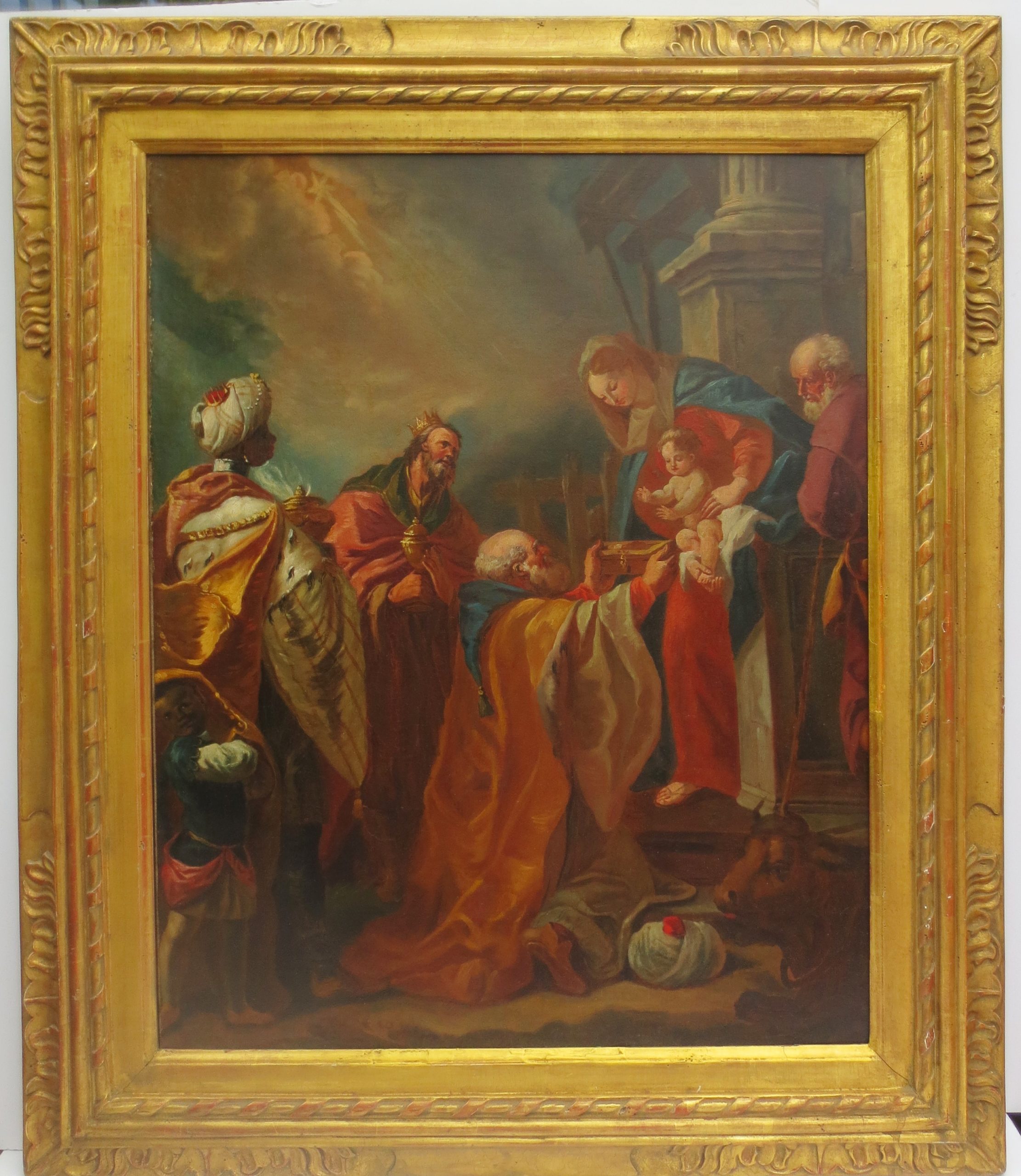Found untouched under dark varnish and dirt in the early 1980s by private collector who had it lined, cleaned and provided carved period style frame.
The composition is loosely derived from a similar arrangement in reverse, twice painted by Sebastiano Ricci, the formal version at Hampton Court dated 1726 and its smaller finished modello x – Seilern and now Courtauld collection. Specific borrowed motifs include the form, features and turban design of Balthazar which Ricci rehearsed in numerous drawings, now at Windsor in the Smith albums but in the 1720s available for copy in Venice. During this period, from 1723 to 1730, the highly regarded German artist Anton Kern (1709-1747) was resident in Pittoni’s studio as an advanced student and then collaborator in several paintings based on Pittoni’s compositions.
The present painting seems a product of the working relationship of Pittoni and Kern. The general composition and many of the component figures introduce a compositional format that, when further evolved, will remain a near generic staple of the Pittoni atelier as is typified by the version datable to 1740 in Brescia. Earlier variants done before Kern’s departure in 1730 are found inter alia Geneva and Cracow, while there are almost a dozen paintings from the later 1720s with some participation by Kern working with and under the aegis of Pittoni. Finally, further evidence of their collegial working relationship, two grisaille drawings in Warsaw of the Massacre of the Innocents and Cleansing of the Temple could serve as fully finished painterly modelli for future replication in oil.
While the basic compositional order and numerous costume and setting details are part and parcel of Pittoni’s pictorial vocabulary syntax into the 1720s, the arrangement is more compactly compressed than it would appear in later years for both Pittoni and Kern. Some variations of emphasis in several of the elements derived from Pittoni serve as markers of Kern’s involvement.
The face of the Madonna leaning towards the kneeling Magus is a slightly thinner oval, her eyelids more rounded downwards and nose slightly sharper than in adaptation of the Venetian tradition and Pittoni’s practice. These minor traits in a facial type would evolve into more assertive form as Germanic Rococo, for which Kern is correctly given generative credit.
In contrast to the face, figure, and turban design of Balthazar (left side of the present painting), all details dependent on Pittoni’s studio models, the kneeling but still erect Magus, differ from the near prostrate position and costume seen in other paintings of this subject by Pittoni from the 1720s(cf. Geneva, Cracow and Brescia). Yet the figure seen in the present painting which was created with and under the guidance of Pittoni was itself based on another similar pathos formula for worshipful acquiescence as seen in a number of Pittoni works and again in almost the same form in two preparatory drawings by Kern done after leaving Venice to work on a large painting of a sacrificial scene, showing not only the arm posture, but also a drapery pattern, long flowing folds charted by deep contiguous valleys.
Finally, the architectural element in the upper right of the present painting differs from the design of other staging architecture in Pittoni studio paintings of the Adoration of the Magi. However, the simple, somewhat old-fashioned Venetian combination of heavy square pedestals and unembellished fluted columns can be near identically matched by columns left and right in the drawing in Warsaw of the Cleansing of the Temple. As this drawing was mate in size and style to another Massacre of the Innocents in Warsaw which in turn proves to have been Kern’s copy after Pittoni’s large Massacre of the Innocents in a Milanese collection, it again seems probable that here too is evidence of the relationship between Pittoni and Kern, engaged both singly and in conjoined efforts in the preparation of modelli for the future production of numerous paintings. Here, one strikingly attractive Venetian painting condenses a survey of the working procedures of the larger and more important Venetian studios in the service of an international elite trade.
All paintings, drawing and related documentary evidence for both Pittoni and Kern can be found in Franca Zava Boccazzi, Pittoni, Venice, 1979; for Kern, cf. Paval Preiss, Anton Kern (1709-1747): A Venetian Master of the Saxon and Bohemian Rococo, Prague, 1998, with full citations of earlier literature including Alice Binion’s essential “Anton Kern in Venice”, Münchner Jahrbuch der Bildenden Künste, Series III, vol. 32, 1981, pp.183-206.

